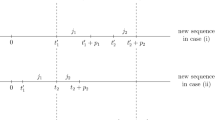Abstract
We study a generalized job-shop problem called the body shop scheduling problem (BSSP). This problem arises from the industrial application of welding in a car body production line, where possible collisions between industrial robots have to be taken into account. BSSP corresponds to a job-shop problem where the operations of a job have to follow alternating routes on the machines, certain operations of different jobs are not allowed to be processed at the same time and after processing an operation of a certain job a machine might be unavailable for a given time for operations of other jobs. As main results we will show that for three jobs and four machines the special case where only one machine is used by more than one job is already \(\mathcal NP \)-hard. This also implies that the single machine scheduling problem that asks for a makespan minimal schedule of three chains of operations with delays between the operations of a chain is \(\mathcal NP \)-hard. On the positive side, we present a polynomial algorithm for the two job case and a pseudo-polynomial algorithm together with an FPTAS for an arbitrary but constant number of jobs. Hence for a constant number of jobs we fully settle the complexity status of the problem.












Similar content being viewed by others
References
Agnetis, A., Flamini, M., Nicosia, G.,& Pacifici, A. (2010). A job-shop problem with one additional resource type. Journal of Scheduling, 1–13.
Akers, S. B. (1956). A graphical approach to production scheduling problems. Operations Research, 4(2), 244–245.
Ausiello, G., Crescenzi, P., Gambosi, G., Kann, V., Marchetti-Spaccamela, A.,& Protasi, M. (1999). Complexity and approximation; combinatorial optimization problems and their approximability properties. Berlin: Springer.
Brucker, P. (1988). An efficient algorithm for the job-shop problem with two jobs. Computing, 40(4), 353–359.
Garey, M. R.,& Johnson, D. S. (1979). Computers and intractability: A guide to NP-completeness. New York: WH Freeman and Company.
Grötschel, M., Hinrichs, H., Schröer, K.,& Tuchscherer, A. (2006). Ein gemischt-ganzzahliges lineares Optimierungsproblem für ein Laserschweißproblem im Karosseriebau. Zeitschrift für wissenschaftlichen Fabrikbetrieb, 5, 260–264.
Ibarra, O. H.,& Kim, C. E. (1975). Fast approximation algorithms for the knapsack and sum of subset problems. Journal of the ACM, 22(4), 463–468.
Middendorf, M.,& Timkovsky, V. G. (1999). Transversal graphs for partially ordered sets: Sequencing, merging and scheduling problems. Journal of Combinatorial Optimization, 3(4), 417–435.
Munier, A.,& Sourd, F. (2003). Scheduling chains on a single machine with non-negative time lags. Mathematical Methods of Operations Research, 57(1), 111–123.
Pinedo, M. (2008). Scheduling: Theory, algorithms, and systems. Berlin: Springer.
Rambau, J.,& Schwarz, C. (2009). On the benefits of using NP-hard problems in branch& bound. In Operations research proceedings 2008 (pp. 463–468). Springer.
Rambau, J.,& Schwarz, C. (2010a). Exploiting combinatorial relaxations to solve a routing& scheduling problem in car body manufacturing. Universität Bayreuth, Preprint.
Rambau, J.,& Schwarz, C. (2010b). How to avoid collisions in scheduling industrial robots? Universität Bayreuth, Preprint.
Schneider, T. (2006). Ressourcenbeschränktes Projektscheduling zur optimierten Auslastung von Laserquellen im Automobilkarosseriebau. Diplomarbeit, University of Bayreuth.
Servakh, V. V.,& Shcherbinina, T. A. (2006). A fully polynomial time approximation scheme for two project scheduling problems. In Information control problems in manufacturing: proceedings of the 12th IFAC (pp. 129–134).
Sotskov, Y. N.,& Shakhlevich, N. V. (1995). NP-hardness of shop-scheduling problems with three jobs. Discrete Applied Mathematics, 59(3), 237–266.
Welz, W. (2010). Route planning for robot systems. Berlin: Technische Universität.
Welz, W.,& Skutella, M. (2011). Route planning for robot systems. In Operations research proceedings 2010 (pp. 307–312). Springer.
Wikum, E. D. (1992). One-machine generalized precedence constrained scheduling. PhD thesis, School of industrial and systems enigeering, Georgia Institute of Technology.
Wikum, E. D., Llewellyn, D. C.,& Nemhauser, G. L. (1994). One-machine generalized precedence constrained scheduling problems. Operations Research Letters, 16, 87–99.
Acknowledgments
We thank the anonymous referees for their fruitful comments that helped to improve this paper considerably. The research was partly funded by the Austrian Science Fund (FWF): P23829.
Author information
Authors and Affiliations
Corresponding author
Rights and permissions
About this article
Cite this article
Schauer, J., Schwarz, C. Job-shop scheduling in a body shop. J Sched 16, 215–229 (2013). https://doi.org/10.1007/s10951-012-0300-2
Published:
Issue Date:
DOI: https://doi.org/10.1007/s10951-012-0300-2




